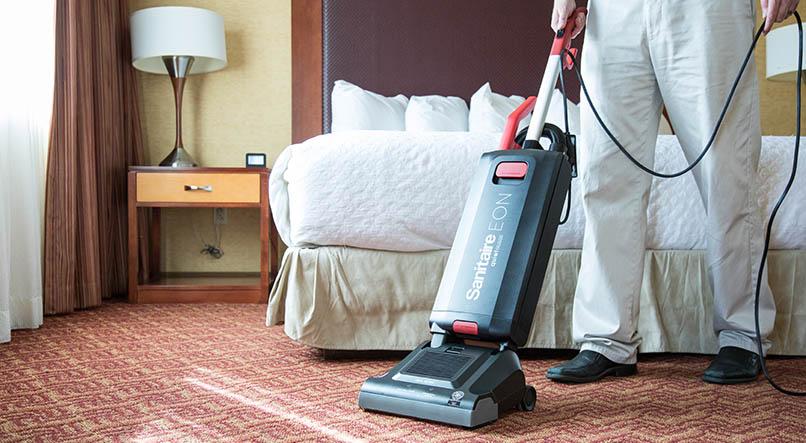
Vacuuming: The First Line of Defense for Carpet

Carpet has long been a preferred flooring choice in many commercial buildings from restaurants and hotels to schools, office buildings and retail stores. It absorbs sound. It can reduce building occupants' exposure to dust and allergens. In fact, studies by the Carpet and Rug Institute (CRI) have shown that carpets retain dust and allergens that would become airborne in hard-surface floor environments and pose a greater health risk.
Most commercial-grade carpet can last 10 years or longer with daily cleaning.
According to The Science of Carpet Cleaning, a study by the Institute of Inspection, Cleaning and Restoration Certification, three types of soils can impact carpet longevity and appearance.
- Dry particles ranging from hair, fiber, pet dander, pollen, sand, gravel, clay and dirt. These substances account for up to 75 percent of the soils found in commercial carpet.
- Soils from sugars, starches and fluids from food particles, sweat and other bodily fluids account for approximately 12 percent of soils in carpet.
- Oily soils from substances such as tar, asphalt residues, automotive lubricants, and animal and vegetable oils that can leave stains, comprise about 10 percent of soils in carpet.
Dry particle soils can be most damaging to carpet. These heavier, gritty soils work their way into the lower third of carpet fibers near the primary backing and break down carpet fibers at their base.
Efforts to protect the investment in carpet starts at the front door, and vacuuming is the primary defense against carpet deterioration.
The study stresses the importance of minimizing the volume of soil that comes in contact with carpet. Daily maintenance of sidewalks and parking lots to limit the amount of gravel, sand and other debris that enter the building is an important step. Building maintenance managers should also invest in walk-off mats and place them immediately inside building entrances to catch and hold destructive soils. The mats should be at least eight feet long -- enough for each person entering the building to take three steps with each foot to remove soil from their shoes. Mats should be vacuumed at least once a day with multiple passes and be professionally cleaned every three to four days to prevent them from overloading with abrasive soils.
Develop a floor-plan map showing the areas that receive the heaviest daily foot traffic, as well as areas that receive less traffic. The CRI publication, Carpet Maintenance for School Facilities, offers an example of how a map can prioritize cleaning practices. The heavy traffic areas should include hallways, inside elevators and near heavy-use office equipment, conference rooms, dining areas or other gathering spaces, etc. These areas should receive a minimum of two vacuum passes daily. Lighter-traffic areas should be vacuumed at least once per week.
Also, make sure to use a vacuum that has earned the CRI Gold Seal of Approval. This certifies that the vacuum captures 55 percent or more of the soil from carpet, emits less than 35 microns of particulates per cubic meter and preserves the appearance and texture of carpet.
Cleaning Spills and Stains
Vacuuming is important in areas where carpet contains soluble or oily soils. Check carpeted surfaces daily for signs of spills and discoloring, and determine the likely sources. Most spills can be cleaned by hand brushing a soap and water solution through the stain and vacuuming the soap residue after it has dried.
For stains resulting from oily substances, a chemical treatment may be necessary. For small areas, a spot application may suffice. Larger areas may require a chemical mixture applied with an extractor. Sanitaire offers a spotter and extractors. Follow the equipment manufacturer's guidelines for the use of chemicals for extraction. The Carpet and Rug Institute also offers a seal of approval program for chemicals used to remove stains from carpet. Once the soil has been removed and the carpet has dried, vacuum the carpet to remove residue as well as heavy soils that might have accumulated below the stain.
Mapping a cleaning plan and using the right equipment for the level of soil are truly the first line of defense to keeping building carpets looking fresh and clean.

Leave a comment